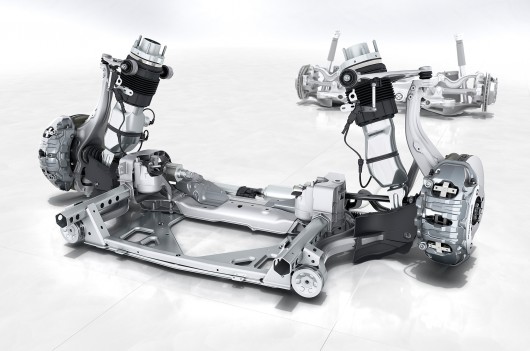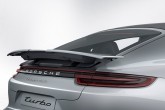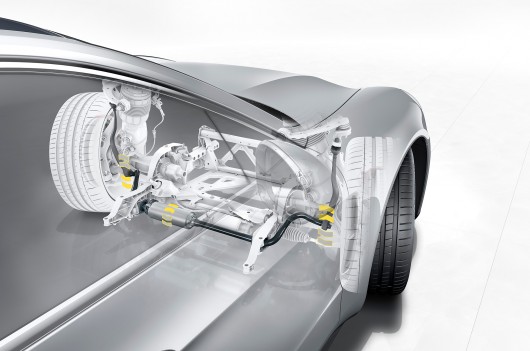15 facts about the new Porsche Panamera 2017
Information you didn’t know about the new 2017 Porsche Panamera

With all the respectability and continuity of style of the previous generation Panamera has not the fame of a sports car, rather it was a typical representative of the business class. Even stretched a profile reminiscent of the 911, not gave the car a true sporty character. That is why in the new generation Panamera engineers have sought not only to improve the technical part, but also carefully worked style.
Body and interior

Despite the impressive dimensions of novelty, it’s still a car that seats four adults, also due to the two separate rear seats. To improve comfort for second-row passengers base was increased by 30 mm, but the need to achieve high aerodynamic performance determined strongly sloping in profile, the roof, reducing the height of the ceiling above the rear seats are 20 mm And various configurations envisage as separate of the rear seat, and a pseudo three seater sofa. Body type is left unchanged – fastback, but thanks to reduced overhangs, he found a visual lightness and closer to the 911.
The interior and options

The interior design completely redesigned, it is now not only harmoniously complement the sporty appearance of the model and acquired a number of technological features, in particular — touch HD screens, which displayed the basic functions of management support systems, including climate control unit.
The only pointer that is saved on the instrument panel is the tachometer. Crowns the Central console is a 12.3 inch touch screen. In addition, if the second row is selected a separate chair, it is possible to order and a second display for the rear passengers. The operating system proposes an improved Porsche Communication Management (PCM). In addition, for extra charge you can order a panoramic roof and seats with a massage function.
The trunk and rear seats
Porsche’s engineers in their quest to enhance the vehicle’s versatility with all its sporty image made the rear seats foldable in parts, allowing you to carry long items. The expediency of this decision, of course, remains in question, since for a vehicle of this level of transportation of goods – the problem is not paramount, but additional functionality is never superfluous.
All-wheel drive system

The Porsche Panamera is equipped with permanent all-wheel drive, but for a sports car rear-drive handling character reveals a much greater potential for extreme driving. This is ensured by the transfer of more torque to the rear axle, which together with air suspension and steering ensures a stable behavior of the machine in any situation.
Aluminum body parts

For perfect balance and reduce the overall weight of the vehicle, it utilizes a number of body elements made of aluminum, such as bonnet, front wings, body sides and roof. It is worth noting that Porsche’s engineers did not use the disputed technology solutions in the form of combining in one body the element of steel and aluminium, as is done in the BMW because of the difficulty of preventing galvanic corrosion significantly reduces the advantages of this combination.
Engine

The car received a new four-liter eight-cylinder engine with output of 550 HP, which is achieved by using a turbocharger with a pressure of 0.3 bar. Because the motor is V-shaped, a turbine mounted in the collapse of the cylinder, thereby reducing the height of the whole structure. The unit turned out to be 21 pounds lighter than comparable previous-generation Panamera.
Transmission

Such a powerful engine is coupled with eight-speed transmission with double clutch. While the seventh and eighth transmission are increasing, and are used for economical driving style. According to the manufacturer, average fuel consumption is 8 liters per 100 km.
The front subframe

For a car with a monocoque body, the application of the subframe is a fairly common solution, in this case it mounts a front adaptive air suspension and optional carbon-ceramic brakes.
Power frame

To improve body stiffness for bending and torsion as the main power components of the platform used highly alloyed steel alloys. This decision is also due to the security requirements.
System shut-down cylinders

With the aim of increasing profitability for the first time Porsche used the system off at low loads four cylinders out of eight. Such a solution has long been used by manufacturers of full-size SUVs, for which disabling of the engine though possible to save fuel, but given the significant weight dramatically reduces the thrust and impact on the resource. As for a sports car with refined aerodynamics and a relatively low weight, the use of such a system can be justified and will not lead to the deterioration of the image.
Front air intakes

Unlike many sports cars, for which huge air intakes is only part of the image, the Panamera they perform many functions: it’s cooling the two radiators of the engine, blowing the brake cylinders compacted air flow and reducing aerodynamic drag.
Rear wing




Because of the need to provide sufficient clamping force on the rear axle, the Porsche engineers had to use wing, which is wider than the dimensions of the car. In order to get this item in a niche tailgate at low speeds, it made a composite of three parts. In addition, the angle of attack of that element is automatically determined speed.
Increase vehicle stability in turns

As an option to buyers of the proposed system Porsche Dynamic Chassis Control Sport, which includes the sway bars come with a 48-volt Electromechanical drives, thus reducing roll of the vehicle during sharp turns. Unlike traditional mechanical stabilization, such a scheme allows to maintain the smoothness of the suspension with a comfortable ride.
The system changes the ride height

Through the use of suspension bellows is increased by 60% capacity, the opportunity to provide a larger clearance of the car by 0.8 inches, as well as adjustments of the aerodynamic angle of attack. Such a decision is not due to manufacturer desire to increase the permeability, and the need to ensure maximum stability at high speeds.
System steer the rear wheels

With a large database of car extremely difficult to give its handling sharpness sports car that reduces driving pleasure and makes driving extremely difficult. To solve this problem, Porsche engineers used a system controlling the position of the rear wheels. So, at a speed less than 30 mph automated rotation of the wheels on the rear axle within 2.8 degrees opposite the front, allowing smooth control and prevents sharp sudden rearrangement of the second axis.

Thus, the new Porsche Panamera has become a surprisingly nuanced and balanced car, which managed to combine the comfort of a sedan business-class and handling sports coupe. In addition, the refinement of style and design make the new generation more aggressively and as close as possible to the sports line of the company.
Author: S. Vasilenko
